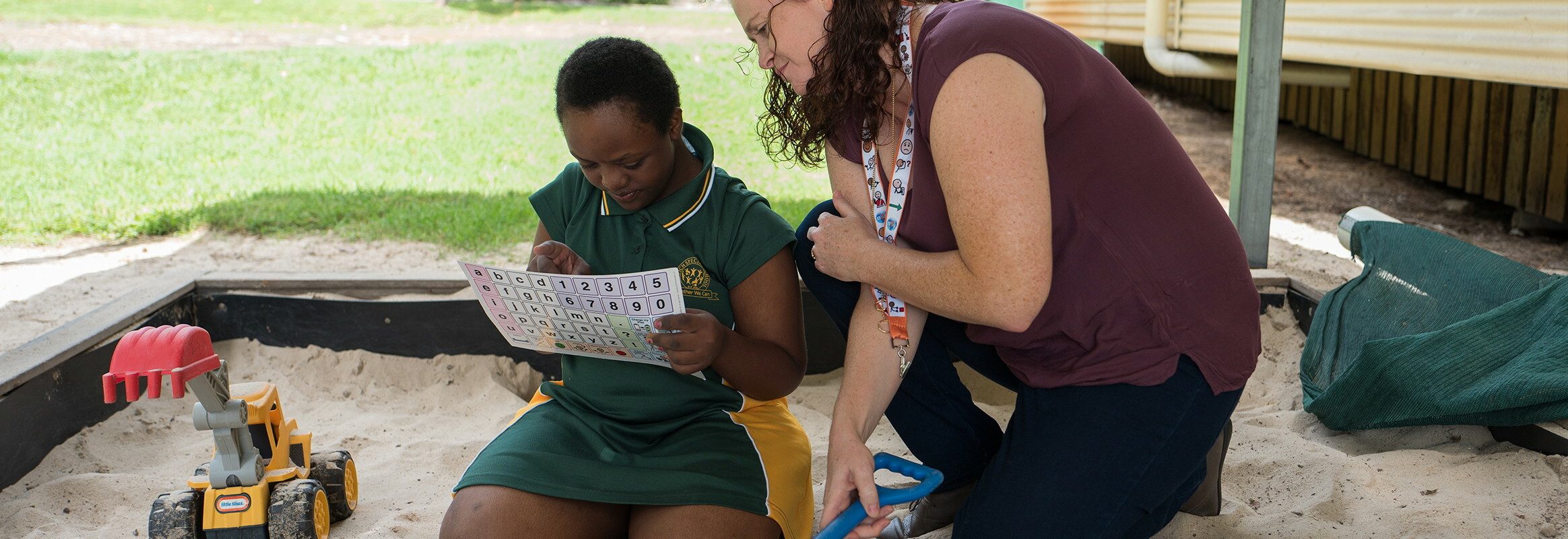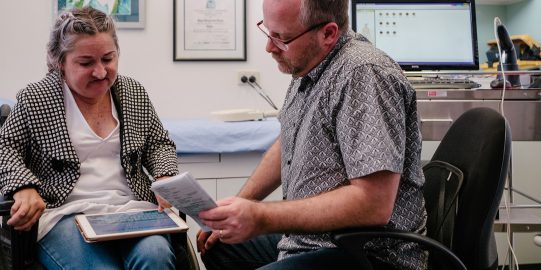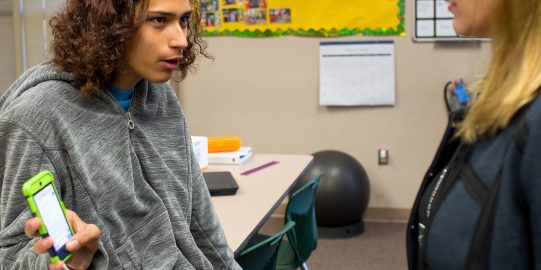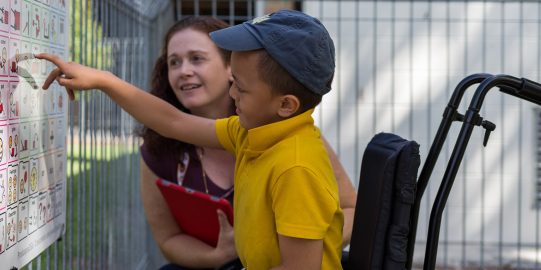People who cannot rely on speech alone depend on Augmentative and Alternative Communication (AAC) to get their messages across every day. But is there a plan for when their usual AAC system is not available, in both routine activities and major crises? Planning ahead can ensure that a back-up system is in place, and the person’s voice is protected.
Planning for communication when AAC is not available
Support all forms of communication, especially on those occasions when the AAC is not available. Make a plan for alternatives.
Sofia woke up in the hospital with no memory of how she got there. She learned, later, that she collapsed at work. She woke in a hospital without her AAC and was unable to ask for it. The nurse who responded to the call bell did not seem to know that Sofia cannot speak. Sofia usually types to communicate, but she suddenly found herself barely able to control her hands and tethered to an IV and monitors.
Daniel usually types his messages or selects symbols on his AAC. Occasionally, however, he becomes very stressed and is unable to clearly form messages. Over time, Daniel and his sister developed a strategy where she lists possible messages in a specific order every time she sees him approaching this state. She starts by saying “I can see something is wrong, Daniel. Is it the noise?” She pauses, and if he doesn’t respond, she continues down a list of possible problems that he needs help to resolve. At times when Daniel cannot form messages, he finds it much easier to simply respond to options. Daniel and his sister do not know there is a word for their strategy: partner-assisted scanning. They just know it works for those times when he struggles the most with communication.
AAC unavailable: make a plan
Every Augmentative and Alternative Communication user is likely to experience environments where their AAC is not easily accessed. Perhaps, the AAC system is broken or out of charge. The screen may be uncomfortably bright at night in bed, while it may not be bright enough outside on a sunny day. At worst, the AAC user could experience an emergency, and end up separated from their AAC.
Although many AAC users we interviewed described multiple tools they use to communicate - matching the right communication tool to the right task - few had a back-up plan for what they would do if they could suddenly no longer access their high-tech AAC.
Make sure you have a plan for how you will communicate if your AAC is not there. Include options in case your ability to access your AAC changes, for example, if you are suddenly unable to use your hands the way you do now.
8 Key strategies when AAC is not available
These practical tips can ensure you have a solid back-up plan for unexpected situations where AAC is unavailable.
1. Ask for AAC
If AAC is not immediately available, and if the AAC user cannot simply go get it, practice ways to ask for it.
Some strategies include:
- Wrist bands or symbol cards to indicate that they need their AAC.
- “Calling out” or vocalizing to get the attention of their communication partner.
- A single-message button programmed to say “Please get my AAC system”. Single-message buttons are even available as wearable technology, such as a single-message watch or keychain.
- A laminated information page that the person carries to share how they communicate, and asking someone to get their AAC system.
2. Be a good communication partner
Communication partners need to be responsive to nonverbal signals that suggest AAC is needed, such as when the AAC user reaches towards or looks at their device. Even when the AAC user is unclear or unable to ask for their AAC, good communication partners take the initiative to invite the use of AAC. AAC should be offered, but not required.
3. Use paper-based alternatives
It is often important to have experience with light-tech paper-based versions of AAC because these can become important back-ups for when usual AAC is not available.
- Create a paper-based copy of the AAC system. Print screen captures of the key pages in the AAC system and laminate them or place in a folder or binder.
- Those who type on an iPad to communicate can make a print-out of the alphabet or keyboard in their AAC system.
- Practice with a low-tech letter-board. This goes for both AAC users and their communication partners. A letter board might be offered in certain care environments, like the hospital. AAC users who are already familiar with using paper-based alternatives are more likely to adapt quickly in different situations when they need to communicate in a different way. In addition, paper-based boards can be helpful in environments or situations where an electronic device may not work well (bright sunlight, swimming pool).
Boards such as these can be fixed to predictable locations so they are easy to access. They can even be enlarged so they become highly visible tools to be used in the environment.
Download a core word board with a symbol-based display of common words and a letter/alphabet board.
4. Use multimodal communication
AAC users are often very strategic at learning to communicate common messages in multiple ways. These multimodal strategies include gestures and pointing, photos or pictures on a phone, drawing or writing, using Google searches, and with body language and facial expression. Any and all of these different ways to communicate help provide back up to AAC.
5. Point to real objects
It is often just as quick and easy to communicate simple wants and needs by using real objects in the environment. Parents and educators may be tempted to encourage AAC learners to “use their words” rather than point to people or objects, but indicating real objects is a helpful backup strategy when AAC is not available.
6. Include visual material
Visuals enhance communication. An AAC user might point to a photo frame on the shelf of their family home or show a photo in their camera roll to set the topic of conversation. Encourage this flexibility with visual materials.
7. Use multiple access methods
Many AAC users have complex bodies. At times this can affect their ability to access their AAC effectively in the way they do normally. For example, during sensory overload, it may be difficult for an AAC user to both look at and point to their AAC. They may benefit from using a different way to access their AAC at that time, such as partner-assisted scanning.
8. Practice Partner-Assisted Scanning
Partner-assisted scanning is a useful strategy for any AAC user. The AAC user listens to their communication partner as they list (or scan) various words, then indicate their preference when they hear or see the word they want. Partner-assisted scanning becomes more efficient and reliable as the AAC user and the communication partner become more experienced with the strategy.
More about partner-assisted scanning:
- The AAC user needs to have an effective and understandable way to indicate their preference, to say ‘That’s the one I want’. It could be with a ‘Yes’ response, a head or body movement, a facial expression, or the pressing of a switch.
- Any communication can be done with partner-assisted scanning. A communication partner can list the words of any topic for an AAC user to select from. This can be a crucial back-up strategy only used in moments when they are unable to access their usual AAC.
Links and References
- Bertram, Mary-Louise. (2015). JW PODD auditory +visual scanning. [YouTube video]
- Cincinnati Children's, (2011). Communicating with Partner Assisted Scanning. [YouTube video]
- Communication Disabilities Access Canada. (2013). Making a communication access card (PDF) and blank communication access card (PDF).
- Hartmann, A & Sheldon, E. (2019). Just Ask: What we can learn from AAC users. [Blog post]
- Low Tech Solutions. (2011). Partner Assisted Auditory Scanning - ALS. [YouTube video]
- Project Core, Partner-assisted scanning quick reference sheet, Center for Literacy & Disability Studies at UNC Chapel Hill.
- We Speak PODD. (2016). Close up demonstration of PODD with partner assisted audio/visual scanning. [YouTube video]
- Zangari, Carole (2017). Emergency Preparedness for the AAC Family, Praactical AAC. [Blog post]
- Zangari, Carole (2012). Five Under-Used Strategies in AAC, PrAACtical AAC. [Blog post]





